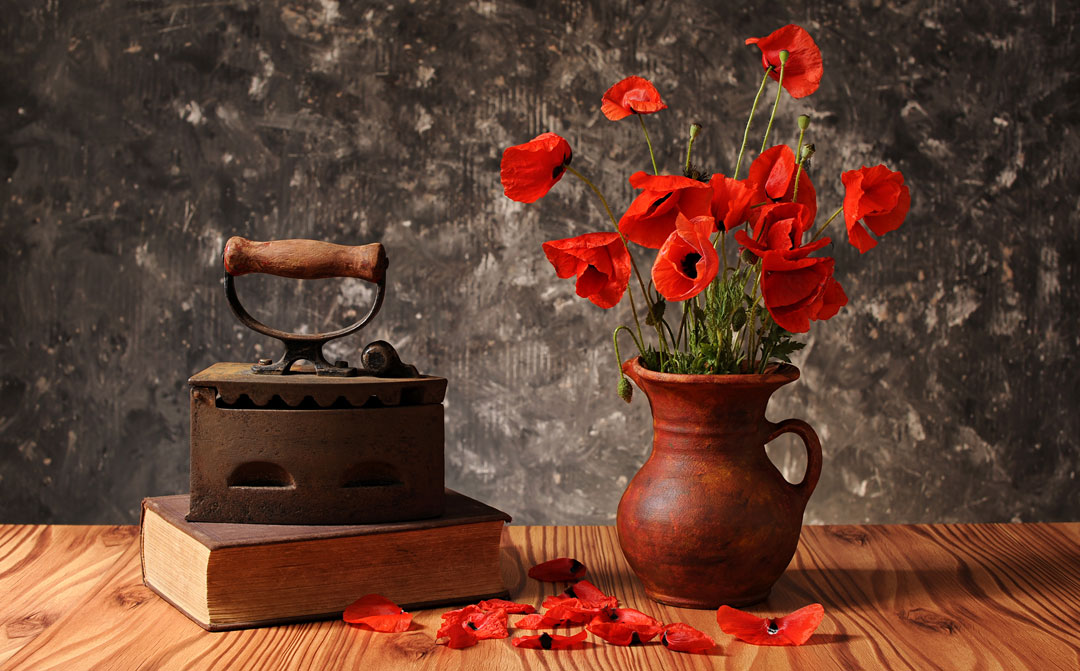During the latter half of the nineteenth century, technology and social advances developed side-by-side. Manual labor was augmented or replaced by machinery; human capital was freed up for other pursuits.
Products developed for war use, such as preserved food and standardized clothing sizes, made their way into everyday life. Advances in medicine highlighted the need for more sanitary conditions and products. Art and music were recorded and reproduced for the first time, enriching the lives of millions.
Within a few short decades, homelife was transformed.
REFRIGERATION AND FOOD PRESERVATION
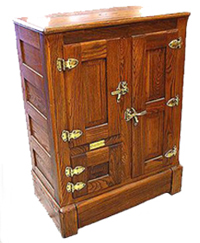 Refrigerators
Refrigerators
Ice and ice houses to chill and preserve food had been in use for a long time, but development of artificial cooling for foodstuffs really began in the early 1800s. Various inventors employed the vapors of ether (Oliver Evans, 1805; Alexander Twining, 1850), ammonia (Michael Faraday, 1820) and other gases (Jacob Perkins, 1834; John Gorrie, 1842) in compressed form to achieve cooling.
In 1856 James Harrison began a series of vapor compression installations using either alcohol or ammonia. These units ushered in the use of artificial refrigeration in a commercial environment, and further embellishments and refinements followed over the next fifty years.
It was not until 1913 that refrigerators for home use were invented by Fred W. Wolfe of Indiana. Five years later the startup refrigerator company, Frigidaire, began mass-production of refrigerators.
IMAGE: English Wikipedia user Magi Media [GFDL (http://www.gnu.org/copyleft/fdl.html), GFDL (http://www.gnu.org/copyleft/fdl.html) or CC-BY-SA-3.0 (http://creativecommons.org/licenses/by-sa/3.0/)], via Wikimedia Commons
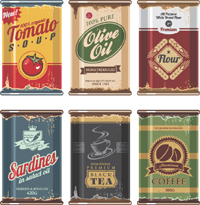 Canned Food
Canned Food
The canning process– sealing food into a sterilized container to prevent spoilage– was developed by a chef, Nicolas Appert, in 1810. He put food in glass jars, sealed them with corks and a layer of sealing wax, and placed them in boiling water. His method was adopted by the French military, who had offered a prize for anyone who could develop a reliable method for preserving food.
Because glass was expensive and difficult to transport, tin or wrought iron cans came into use almost immediately. Can openers, however, were not developed until 1855 in England; until then soldiers had to use their bayonets to open the cans, or simply smashed them open with rocks.
The double-seamed can, which was a great advance in preserving the crucial air-tight seal, came into use in 1888. This method also reduced the use of hazardous lead solder, although its complete elimination in canning did not occur until 1991 in the U.S..
Glass jars continued to be used for home canning. The Mason jar was patented in 1858 by John Landis Mason and used a zinc screw-on cap. An alternative closure using a lever arrangement to seal the lid was also used.
HOUSEHOLD AND KITCHEN APPLIANCES
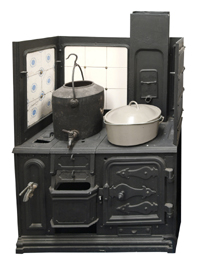 Closed Cooking Ranges and Stoves
Closed Cooking Ranges and Stoves
Cast-iron stoves came into use in the 1830s. The first closed-oven cooking ranges followed shortly in the late 1840s. Gas stoves appeared about the same time, but were slow to catch on due to safety concerns. The coal stove was, however, a powerhouse of cooking efficiency:
“With proper management of dampers, one ordinary-sized coal-hod of anthracite coal will, for twenty-four hours, keep the stove running, keep seventeen gallons of water hot at all hours, bake pies and puddings in the warm closet, heat flat-irons under the back cover, boil tea-kettle and one pot under the front cover, bake bread in the oven, and cook a turkey in the tin roaster in front.” —American Woman’s Home, Beecher, Catharine Esther; Harriet Beecher Stowe (1869)
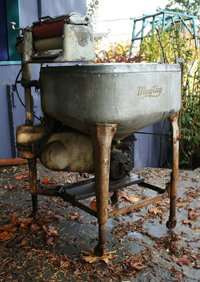 Washing Machines
Washing Machines
Washing machines first appeared in the late 1700s, but it was not until 1843 that a machine was patented in Canada that combined a washing operation with rollers for wringing out the clean clothes. Improvements on the concept were exhibited at the 1862 London Exhibition and again in the Women’s Pavilion at the Centennial International Exhibition of 1876 in Philadelphia.
Electric machines appeared around the turn of the century, but it was not until the 1930s that spin dryers were available to replace the hazardous power wringers. Bendix introduced the automatic washing machine in 1937. Although production of washing machines was curtailed during World War II research continued, and fully automatic machines became the norm after the war.
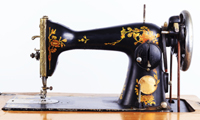 Sewing Machines
Sewing Machines
The earliest sewing machines appeared in the late 1790s. They used a chain stitch, and were intended for industrial uses such as sewing leather harness or canvas sails. The machines were not commercially successful for the first forty years or so.
In the 1830s and 1840s a series of significant improvements to the design were made, including use of a lockstitch instead of a chain stitch, modifications to the needle and shuttle (bobbin) designs, and refinement of the feed mechanism.
Many inventors contributed to the development of the machine, and also to the brief but fierce patent battles that arose over their contributions. Elias Howe patented a machine that held fabric vertically in 1845; Isaac Merritt Singer contributed the vertical needle and presser foot; Allen B. Wilson added a rotary hook in place of the shuttle and formulated the fabric-feed method still in use today.
Sewing machines cut production time for men’s shirts and women’s dresses to a tenth of that needed using manual methods, freeing up significant time for the average housewife.
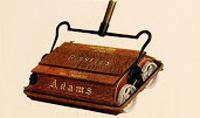 Carpet Sweepers and Vacuum Cleaners
Carpet Sweepers and Vacuum Cleaners
Carpet sweepers were first patented by American Melville R. Bissell in 1876, and devices using the same general design are still in use today.
Vacuum cleaners are actually older than sweepers. Ives W. McGaffy invented the first hand-pumped cleaner in 1865 amd patented it in 1869. However, the awkward mechanics of generating a vacuum while simultaneously moving the apparatus across the floor made the invention more a curiosity than a practical appliance.
It was not until an asthmatic janitor named James Murray Spangler devised an electric version in 1907 that the device became truly usable. He sold his invention to a cousin whose husband, William H. Hoover, became the first president of the Hoover Company.
Carpet sweepers and vacuum cleaners did clean more thoroughly than manual methods such as carpet beaters and brooms. However, standards for cleanliness increased at the same time, so no time savings were recognized as they were with the sewing machine.
MISCELLANEOUS
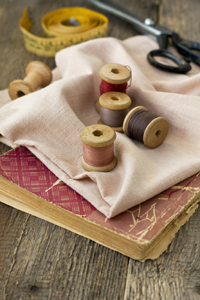 Paper Patterns, Pins, and Safety Pins
Paper Patterns, Pins, and Safety Pins
Sewing became easier and faster with the invention of the sewing machine, but other advances were important as well.
Paper patterns were first produced in the early 1830s and were often sold as part of women’s fashion magazines such as Godey’s Lady’s Book, in vogue before and immediately following the Civil War.
Simple pins have been around for thousands of years, but significant advances in their manufacture and presentation for sale were made by Samuel Slocum in the 1840s. He invented a machine to make pins with solid heads and also a machine for sticking the pins in a paper holder for sale.
Walter Hunt invented the safety pin and patented it in 1849. His design incorporated a spring and guard for the first time. He sold the rights to W. R. Grace and Company to pay off a $15 debt to a friend, not realizing that his invention would ultimately be worth millions of dollars.
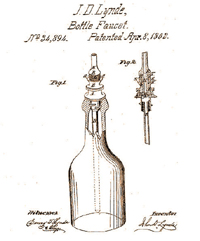 Aerosol Dispenser
Aerosol Dispenser
On April 8, 1862, John D. Lynde of Philadelphia patented the first aerosol dispenser, the J.D. Lynde Bottle Faucet. However, the first aerosol spray can was not patented in the U.S. until 1931, by an inventor named Erik Rotheim.
Presumably, neither inventor foresaw graffiti or ozone depletion.
 Coffee Percolator
Coffee Percolator
Sir Benjamin Thompson (1753-1814) was a prolific inventor, scientist, and soldier. He is most fondly remembered for his contribution to the design of the humble coffee pot.
Instead of simply boiling coffee grounds in the bottom of a pot, Sir Benjamin suspended them in a basket and let boiling water drip through them. His method did not, however, automate the delivery of boiling water over the grounds.
In 1889 an Illinois farmer named Hanson Goodrich added the rising tube and percolating basket, creating the continuous brewing process familiar today.
 Mousetrap
Mousetrap
We have William C. Hooker of Abingdon, Illinois, to thank for the invention of the spring-loaded mousetrap in 1894. Inventors have been trying to develop a better one ever since.
ENTERTAINMENT
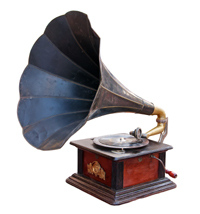 Audio Recordings
Audio Recordings
Devices using cylinders with raised pins to play melodies had been around since the 15th century, and for centuries were the only source of music other than live performance.
Then, in 1857, the Parisian inventor Édouard-Léon Scott de Martinville patented the the phonautograph, which etched soundwaves onto a roll of soot-covered paper. The first audio recording of the human voice was created in 1860, a vocalist singing “Au Clair de la Lune”. There was, however, no method for playing these recordings back.
In 1877, Thomas Edison invented the mechanical phonograph cylinder, and patented it in 1878. This invention was later refined into the gramophone disc, generally credited to Emile Berliner and commercially introduced in the United States in 1889. The age of sound recording and reproduction had dawned.
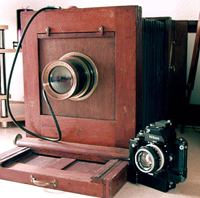 Still Photographs
Still Photographs
The Chinese discovered the principle of the pinhole camera in the fifth century B.C., but there was at that time no method for capturing and preserving the images.
It was not until the late 1700s that photosensitivity of silver compounds was discovered by Swedish chemist Carl Wilhelm Scheele. The first permanent photograph of a camera image was made in 1826 by Joseph Nicéphore Niépce.
By 1837, Louis-Jacques-Mandé Daguerre succeeded in fixing photographic images with a common salt solution. This was an important advance, but the early daguerreotype cameras required exposure times of 5 to 30 minutes, resulting in images that were either blurred or overly stiff and posed. Improvements continued to be made, and by the 1850s the collodion wet plate process gradually replaced the daguerreotype.
By the time of the Civil War, photography was an established medium, leaving us a stunning pictorial history of the conflict.
IMAGE: By Frank Gosebruch (Own work) [CC-BY-SA-3.0 (http://creativecommons.org/licenses/by-sa/3.0)], via Wikimedia Commons
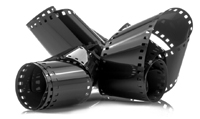 Roll Film
Roll Film
In 1889, George Eastman invented flexible photographic film, which allowed multiple images to be taken and stored in a compact space. He also introduced the first Kodak camera, which took 100-exposure rolls of film that gave circular images roughly 2-1/2 inches in diameter.
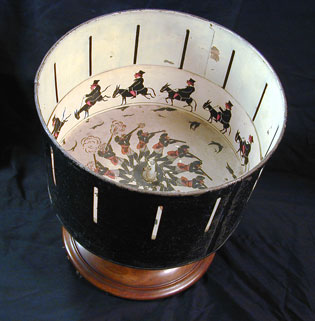 Moving Pictures
Moving Pictures
The zoetrope was a toy that let the viewer see pictures on the interior of a cylinder through a series of slots. It produced the illusion of moving pictures and was invented in 1834 by William Horner.
A later version, called the praxinoscope, was invented by Emile Reynaud in 1877. It used mirrors instead of slits, giving a brighter and less distorted picture than the zoetrope offered.
The zoetrope and the praxinoscope demonstrated that the illusion of movement could be achieved by viewing incrementally different pictures in rapid succession. When that principle was combined with the new flexible film developed by Eastman, modern cinema had arrived.
IMAGE: Created by the North Carolina School of Science and Mathematics, licensed under Creative Commons CC-BY http://creativecommons.org/licenses/by/3.0.
FURTHER READING AND OTHER REFERENCES
Technology, Commercial
Art and Culture
Communications
Lighting
Transportation
Beecher, Catharine Esther and Harriet Beecher Stowe. American Woman’s Home. (1869)
(Posted January 2014)
